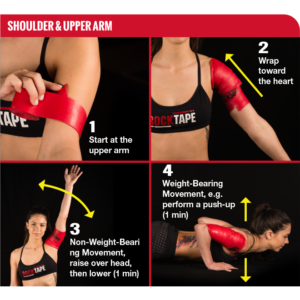by Mitch Hauschildt, MA, ATC, CSCS
There are a lot of treatment options and approaches to treating shoulder pain and dysfunction. Of course I love things like shoulder stability exercises, stretching (when applicable) and postural corrections, but there are a lot of other interventions that work well for me and my patients. Here are 5 of my favorites:
- Positional Release Therapy: PRT is my go to for specific soft tissue work for areas of the body that are sore and tight. The premise of PRT is that you simply find a painful or sore area of the body, place pressure on it and put the area of the body into a shortened position. This makes it effective in changing tone and pain while also making it very comfortable for the patient. There are a lot of different versions of this type of soft tissue work so feel free to utilize your technique of choice with this concept. Areas that I prefer to address with PRT for shoulder patients are the bicep, pec major, pec minor, supraspinatus, upper trap, and infraspinatis.
- Nerve Glides: Whether you refer to them as glides, flossing or neurodynamics, all of these are trying to mobilize a compressed and cranky nerve. This is done by moving the nerve independent of the tissue surrounding it. You can perform self nerve glides, but I prefer to perform them manually myself on my patients to maximize the results. Make sure that you toe the line between mobilizing the nerve and irritating it. For those who have been immobilized in a sling, I find that the median nerve is a mess, so definitely address it, but don’t ignore the radial nerve and the ulnar nerve.
- Joint Mobilization: Oftentimes a shortened joint capsule causes and/or contributes to shoulder pain. This is especially true of the posterior capsule, inferior capsule and into shoulder internal rotation. I prefer to start my joint mobilizations very quickly after an injury (if acute) or surgery to prevent any capsular shortening from occurring.
- Compressional Floss Band: I have a bit of a love affair with floss bands. They are such a valuable tool that can do so much with a very simple tool. They can be used to increase range of motion, decrease pain, and improve stability. I also like floss bands for improving postural control or movement patterns by changing the direction that the band is wrapped.

- Trunk Stabilization: I know this is a bit of a big topic to cover here, but maybe I can cover it in another post, but the high level overview that I want you to understand is that the body will always rob stability from one part of the body to make up for a lack of stability elsewhere. So, if a patient has poor midline control, they may rob stability from the shoulder which could decrease their available range or stability. Any time that I see anterior shoulder pain (think biceps tendonitis), I immediately go after trunk stability because I find that they are usually trying to improvise their lack of trunk stability with the bicep. Without midline control, shoulder function will never be optimal.
This is certainly not a comprehensive list, and I anticipate that it will probably increase over time. There are a ton of ways to treat a shoulder. But, I am confident that if you utilize these 5 concepts that you will see strong, more stable and better functioning shoulders.


Leave a Reply